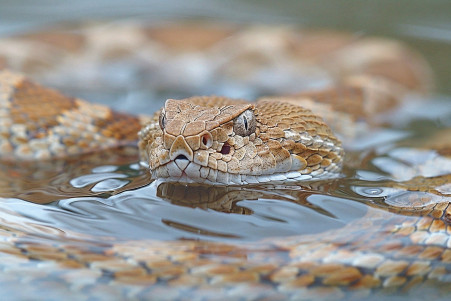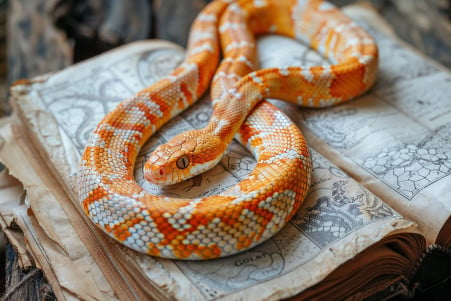Do Snakes Jump? The Fascinating World of Snake Locomotion
5 April 2024 • Updated 4 April 2024

Despite popular belief, there are some snakes that can jump, and it may surprise you to learn just how far they can do it. While snakes are generally thought of as animals that move by slithering, some arboreal and terrestrial species can jump vertically by using their muscles to push off the ground.
In this article, we'll explore the phenomenon of snake jumping through field observations and biomechanical research that has revealed the physiological changes that have made it possible for different species of snakes to jump. This research comes from a variety of fields, including herpetology, evolutionary biology, and functional morphology, and looks at the evolutionary reasons for the development of these movements and the ways they may help snakes in their environments. You may be surprised to learn just how athletic snakes can be.
Can snakes jump?
The Biomechanics of Snake Flight
The biomechanics of snake flight are a truly amazing example of evolutionary adaptation. To launch themselves into the air, the snakes of the genus Chrysopelea use a vertically looped motion to contract their muscles in a specific sequence to push off a branch, as shown in a Nature Physics study by a team from Virginia Tech.
Once in the air, the snake undergoes a dramatic change in body shape - it flattens from head to vent to create a triangular cross-section, with a flat ventral surface and lateral "lips" that likely provide lift, according to a paper in the Journal of Experimental Biology. This, combined with the snake's high angle of attack of 20-40 degrees, creates vortices that generate aerodynamic forces similar to those acting on a wing or parachute.
However, the snakes' ability to glide in a stable and controlled manner is due to their dynamic, three-dimensional undulating movements. As the snake glides, its body forms a wide "S" shape, with the head moving from side to side and the rest of the body moving up and down, creating traveling waves that counteract the destabilizing forces of roll and pitch, as shown in research from Ars Technica. Smaller snakes are better gliders, with their lower mass allowing them to travel further in the horizontal plane.
While the genus Chrysopelea has evolved specialized adaptations for gliding, their sister taxon Dendrelaphis uses similar dynamic movements to cross gaps between branches rather than glide for long distances. A Journal of Experimental Biology study showed that Dendrelaphis snakes adjust their movements based on the distance they need to cross, but they don't use the stereotyped "J-loop" launch of Chrysopelea, suggesting that gliding evolved by modifying the ancestral ability to cross gaps. This demonstrates the biomechanical continuum between jumping, gliding, and arboreal locomotion in snakes.
Evolution of Snake Jumping and Gliding
The evolution of snake jumping and gliding can be understood in the context of the snakes’ shared ancestry with the sister lineage Dendrelaphis. As studies have shown, Dendrelaphis snakes exhibit dynamic gap-crossing behaviors that may have provided the basis for the more specialized gliding adaptations of Chrysopelea.
One research found that Dendrelaphis adjust their movements as the gap they need to cross gets larger, similar to Chrysopelea. This indicates that the dynamic behaviors Chrysopelea uses to initiate glides may have been co-opted from ancestral gap-crossing behaviors. The authors suggest that jumping likely evolved before true gliding, and that Chrysopelea modified these dynamic behaviors for aerial locomotion.
The snakes’ environment, including habitat structure and prey availability, likely played a role in the evolution of these unique adaptations. The snakes’ complex arboreal habitats likely created selective pressures that led to the evolution of better leaping and gliding abilities to help with tasks such as gap crossing, predator escape, and hunting. The ability to dynamically cross gaps and take to the air would have been a major ecological advantage, leading to the evolution of these extraordinary snake behaviors.
Conservation Status and Threats to Flying Snake Species
All five species of flying snakes in the genus Chrysopelea are currently listed as being of "Least Concern" on the IUCN Red List. According to Wikipedia, the paradise tree snake (Chrysopelea paradisi) was last evaluated in 2011 and was determined to have stable populations in multiple Asian countries.
Despite this, flying snakes are not without threats. A-Z Animals explains that habitat destruction and persecution by humans who mistakenly believe the snakes are venomous are potential dangers. In addition, the effects of climate change could be felt in the arboreal forests where they live.
Conservation efforts are ongoing to protect flying snakes and their habitats. National Geographic points out that flying snakes are not popular in the pet trade, so they are not at high risk of being poached. However, it is important to make sure that their forest homes remain healthy to ensure the snakes' continued survival.
The loss of flying snakes would have a significant impact on their ecosystems. As The Animal Facts points out, they are important predators of small mammals, birds, and other vertebrates. Not only is it important to maintain their genetic diversity for study, but it is also important for the overall biodiversity of their habitats.
Studying Snake Flight: How Researchers Investigate Technological Implications
The investigation of snake flight has made use of a variety of cutting-edge research methods and technologies. For example, as Phys.org explained, researchers such as Jake Socha have used synchronized high-speed video cameras to record the 3D flight paths, velocities, and body orientations of gliding snakes like the paradise tree snake (Chrysopelea paradisi) and golden tree snake (Chrysopelea ornata).
This motion capture information has been essential for creating digital models that can replicate the intricate kinematics of snake flight, as ScienceDaily pointed out. Socha and his team have also employed computational fluid dynamics simulations to analyze the aerodynamics of the snake's triangular cross-section, as shown in a Journal of Experimental Biology paper.
Although these methods have provided critical information, there are also significant challenges to studying snake flight in the lab and the wild. For example, as ASME explained, the rapid, undulating movements of the snakes as they glide have made it difficult for researchers to capture all of the details of their flight. Nevertheless, the Virginia Tech team has worked to overcome these obstacles, creating a 3D mathematical model that Virginia Tech News said is essential for understanding how aerial undulation stabilizes snake flight.
The implications of this research go beyond just understanding the biology of snakes. Biomimetic engineers are looking at how the adaptations of flying snakes could be used to develop new gliding and even flying robots, as suggested by the ASME and Virginia Tech News articles. The knowledge gained from studying these extraordinary reptiles could eventually be used to improve search and rescue, disaster monitoring, and other applications.
Where Are Flying Snakes Found and What Do They Eat?
The five species of flying snakes in the genus Chrysopelea are distributed across a large area, from western India to the Indonesian archipelago. According to Britannica, these long, slender, arboreal snakes are native to South Asia and Southeast Asia, including India, Sri Lanka, Malaysia, Indonesia, and the Philippines.
These snakes are important predators in their forested ecosystems. Their diet consists primarily of lizards, including geckos and agamids, but they also eat small mammals, birds, and other snakes, according to Animalia.bio. The Fact Animal explains that flying snakes are thought to spend most of their time in the trees, where they use their gliding ability to hunt and escape from predators.
Flying snakes are also important in the mythology and culture of some of the areas in which they live. BioDB points out that although they are venomous, Chrysopelea snakes are not dangerous to humans because their venom is mildly toxic and has evolved to subdue small prey.
It's important to protect the diverse ecosystems that flying snakes inhabit. As Britannica and other sources note, habitat destruction and human hunting are threats to flying snake species. Protecting the health of the trees and forests that they live in will be important to ensuring that these unusual snakes and their important ecological roles continue to exist in the future.
Conclusion: The Surprising Aerial Prowess of Snakes
The studies discussed in this article have shown that certain species of snakes are capable of jumping and gliding in ways that defy the common image of snakes as purely ground-dwelling animals. The biomechanics and evolutionary history of these behaviors are fascinating and demonstrate the incredible versatility of the snake body plan.
While flying snakes are currently listed as species of "Least Concern" on the IUCN Red List, ongoing conservation efforts are essential to ensure that these unusual reptiles and the environments they live in are protected. Not only does this help maintain the diversity of these amazing gliding snakes, it also ensures that there will be opportunities for future research and potential technological innovations based on their aerial abilities.
The study of snake flight has used a variety of cutting-edge research methods, from high-speed videography to computational modeling, to uncover the complex mechanics and stabilization techniques that make snake flight possible. As researchers continue to expand our knowledge, the possibility of biomimetic developments and advances in fields like robotics and disaster response is an exciting one.
In the end, the jumping and gliding abilities of snakes show that the natural world is full of surprises and that even the most well-known animals can have hidden talents that are waiting to be discovered through scientific research and a willingness to question our assumptions.


